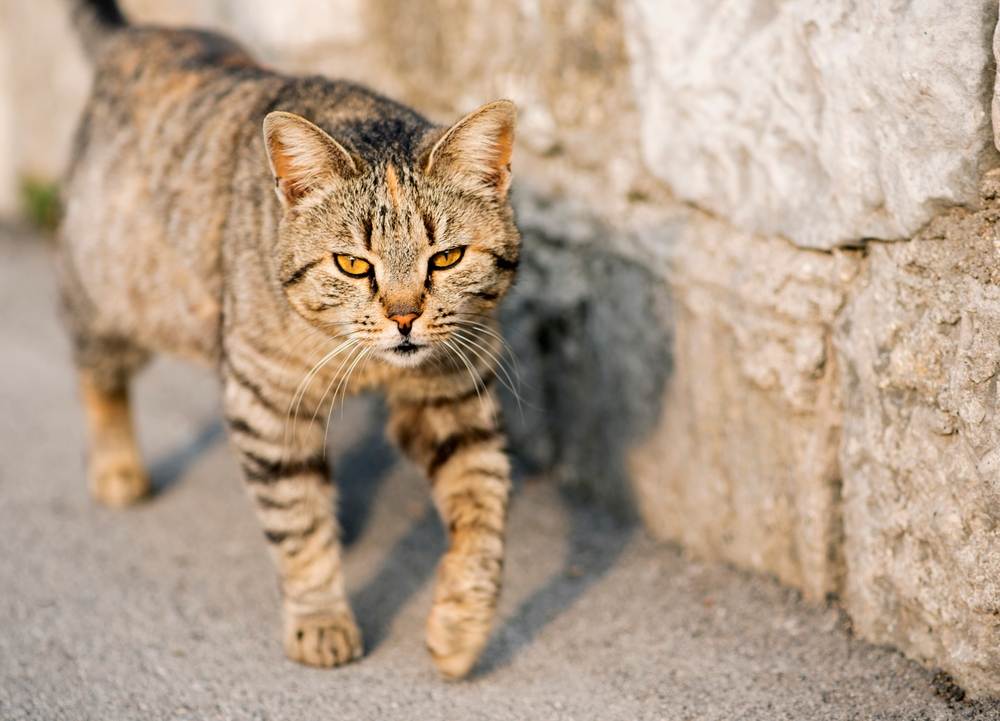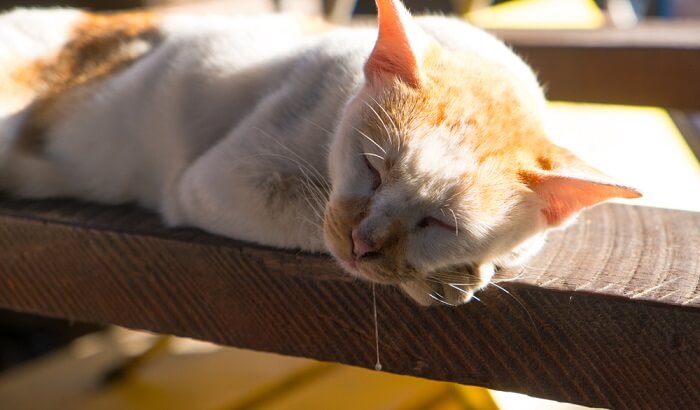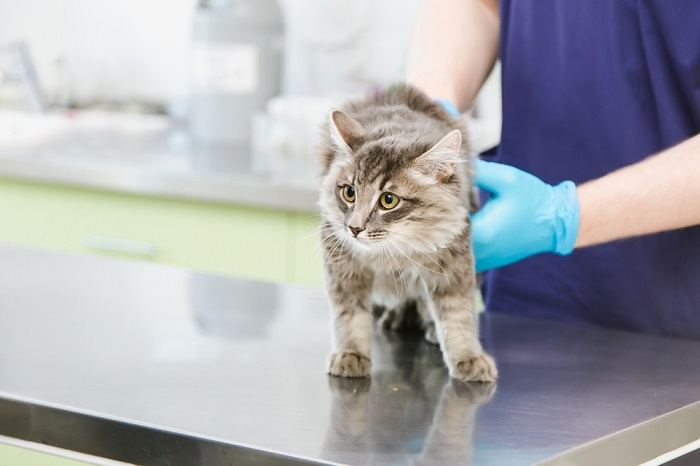
Heatstroke in cats is a very serious medical emergency that requires immediate veterinary care. In this article, you’ll learn the causes of heatstroke in cats, how to recognize signs of illness, how heatstroke is treated, and some frequently asked questions.
Quick Overview: Heatstroke In Cats





What Is Heatstroke?
Heatstroke, also written as heat stroke, occurs when a cat is exposed to a hot or humid environment, contributing to the body’s internal temperature increasing to a level so high that it can cause internal damage to the body.
Although cats might have elevated temperatures for many reasons, heatstroke is usually defined as a pet with a core body temperature over 105 degrees Fahrenheit with a history of exposure to a hot or humid environment.
Heatstroke is a serious form of hyperthermia but it is not the same as having a high fever. A fever involves the body’s own response to infection or inflammation. Hyperthermia involves an outside influence on the body, causing an increased temperature.
Up to a certain point, the body can adapt to a higher temperature. But with heatstroke, external heat temperatures increase the body’s temperature so high, they exceed the body’s ability to regulate its own temperature.
Also Read: Why Does My Cat Feel Hot To Touch? When To Worry
Causes of Heatstroke in Cats

When a cat’s surroundings are very hot, their body temperature can raise to dangerous levels.
Heatstroke is caused most often when an animal is exposed to a hot, humid environment. But it can also be caused even in temperatures we don’t consider “hot” if ventilation is very poor.
Unlike people, who have sweat glands all over our bodies, cats can only sweat a little between their foot pads. They have a reduced ability to dissipate heat even compared to dogs because dogs can engage in evaporative cooling by panting. Cats can pant, but it is usually not a normal thing to see and indicates a cat is either very stressed or overheated.
Here are some common causes of heatstroke in cats:
- Hot temperatures: Any outdoor temperatures exceeding 75 degrees Fahrenheit could be considered “too hot.” Cats that sit in the sun, especially outdoors, can be at risk. Most cats will relocate if they get too hot. But if they are trapped, cannot relocate, or are ill or injured and cannot move, risk for heatstroke increases.
- Humid conditions: Humidity can make it harder to efficiently breathe or ventilate. Humidity also increases the need to sweat. But for animals that cannot sweat efficiently like cats, humidity makes it very difficult to dissipate heat. This can lead to heatstroke even with milder temperatures in the lower 70s.
- Poor ventilation: We often think of a hot car as a big risk factor for heatstroke, and it is for sure. But cooler temperatures in spaces with poor ventilation can lead to heatstroke as well. Studies have shown that the temperature in a car can increase by up to 40 degrees over the course of an hour. In 70 degree weather, this can still lead to temperatures of more than 100 degrees inside the car.
- Poor access to water: It’s always important to provide access to fresh, cool water. Mild overheating can be helped by moving to shade and drinking some water. A cat without access to water might not be able to adjust or manage as well in warmer conditions.
- Poor access to shade: If a cat is too hot, their first instinct is to seek out shade. Cats that love sunbathing will usually seek out shade when they get too warm. However if there is no access to shade and they can’t relocate, this increases heatstroke risk.
Also Read: Cat Body Temperature: Causes & Treatment of Abnormal Body Temperature
Cats at Higher Risk for Heatstroke
Some cats might be at higher risk for heatstroke because of their body conformation or other conditions, including:
- Overweight cats: Excess weight leads to earlier exhaustion by the body and decreased ability to adapt to changing environmental conditions.
- Flat-faced (brachycephalic) cats, like Persians: These cats often cannot breathe as efficiently and their bodies are not as efficient at cooling incoming air through their nasal passages.
- Cats with thicker/heavier fur coats: Very heavy fur, including shorter fur that is badly matted, can trap heat.
- Very young or very old cats: The ability to adapt to changing conditions is reduced in the very young or old and their immune function is less efficient compared to healthy adult cats.
- Cats with respiratory or heart conditions: These cats might already have problems breathing efficiently and their bodies might not be able to adapt as well internally to warmer temperatures.
- Sick or injured cats: These cats might be less inclined to relocate when conditions become too hot or may be unable to.
Also Read: Why Do Cats Love To Sunbathe?
Symptoms of Heatstroke in Cats

Drooling or panting are early signs of heatstroke in cats.
There are several signs of heatstroke in cats. They have been divided into signs that might be seen earlier and later signs indicating grave heatstroke.
Early Signs
- Sweaty paw pads
- Panting
- Restlessness, agitation
- Hypersalivation or drooling
- Red gums and tongue
Later Signs
Regardless of whether signs are early or late, any signs of heatstroke need to be assessed as soon as possible by a veterinarian. If you’re not sure if hyperthermia or heatstroke are occurring, you can try to obtain a rectal temperature if you’re comfortable doing so. A cat showing these symptoms with a body temperature exceeding 105 degrees Fahrenheit would indicate heatstroke.
Also Read: How To Keep Cats Cool In Summer
Complications of Heatstroke
The biggest danger of heatstroke is what the increased temperatures do to the body internally. When the body’s temperature increases and exceeds the body’s ability to thermoregulate internally, heat-related organ damage can occur. This is called thermal injury. Some effects of thermal injury include:
- Circulatory system effects: Excessive dehydration and heat injury can damage the bone marrow where blood cells are made. This can lead to shock from poor blood volume, thick sludgy blood, and disorders with blood clotting.
- Neurologic effects: Thermal injury can lead to damage to brain tissue and fluid swelling around the brain. This is what leads to effects like stuporous behavior, tremors, seizures, and coma.
- Liver effects: Heat-related destruction of liver cells and tissue can occur, leading to concerning compromises in the liver’s involvement with detoxification, immune function, blood clotting function, and digestion. These effects can increase the risk for bacterial infection inside the body.
- Kidney effects: Thermal injury can lead directly to acute kidney failure, which can be worsened by effects on the circulatory system
- Gastrointestinal effects: Thermal injury can directly damage the GI tract, contributing to vomiting and diarrhea. Risk is also increased for bacteria normally living in the intestinal tract to migrate to other parts of the body, causing serious infection.
Diagnosis of Heatstroke in Cats
Heatstroke is presumed in cases where the rectal temperature exceeds 105 degrees Fahrenheit and signs of overheating are present, such as panting, drooling, etc. Your veterinarian will ask about conditions leading up to these signs of illness to determine if there is a history of exposure to a hot or poorly ventilated environment.
Diagnosing how serious heatstroke is depends on the severity of signs and symptoms seen when the cat arrives at the vet. Your veterinarian will also run lab work once your cat’s condition is more stable to look at the effects of thermal injury on the function of organs like the kidney, liver, and circulatory system.
Because some health effects of heatstroke can be delayed it’s important to provide your vet with any relevant history for at least the previous three to five days.
Treatment for Heatstroke in Cats

If your cat is overheated, bring them to the veterinarian right away, even if their symptoms seem mild.
If you suspect heatstroke in your cat, it’s very important to get your cat to the vet as soon as possible. At first, it might not be apparent just how serious the condition is, and the longer heatstroke goes untreated, the greater the risk there is for the effects of thermal injury to worsen.
When a cat arrives at the vet for heatstroke, a rectal temperature is confirmed and your vet will quickly look to determine if heatstroke is present versus a high temperature from a fever. The immediate goal is to lower the body temperature to 103 degrees Fahrenheit within 30 to 60 minutes.
Intravenous fluids are the most important thing to start with heatstroke, as this helps correct dehydration, replenish lost electrolytes, cools the body internally, and helps provide better blood flow to internal organs.
Your vet may also employ other cooling mechanisms like cold packs on the bottoms of the feet and in the armpits and groin, spraying your cat lightly with water and providing a fan for evaporative cooling, and providing oxygen support.
Antibiotics are often used because of the high risk for bacteria within the GI tract to migrate to other parts of the body because of internal organ damage.
Steroids and nonsteroidal anti-inflammatory drugs (NSAIDs) are typically not used. Unlike with a fever, these drugs cannot lower the body’s internal temperature in cases of hyperthermia or heatstroke. Internal damage to the liver or kidneys can also affect the body’s ability to metabolize these drugs.
Mild cases of heatstroke might be treated in a general practice setting. Severity might be determined based on your cat’s initial condition as well as abnormalities found with lab work.
More serious and complicated cases might require your vet to transfer your cat to an emergency hospital that has capabilities for continuous 24-hour care. Advanced cases of heatstroke can require several days of intensive care. If the bone marrow has been damaged from heat injury, whole blood or plasma transfusions might be necessary to correct damage to red blood cells and platelets.
The prognosis for heatstroke in any pet can be very guarded. Even if the elevated temperature is corrected, the effects of thermal injury might have already caused internal damage. Generally, if a cat experiencing heatstroke survives the first 48 hours, the outcome is much more favorable.
Heatstroke: First Actions

If you suspect heatstroke, take a few quick steps to begin cooling them down at home, then quickly transport them to a veterinary hospital.
It is very important to get your cat to the vet as soon as possible if heatstroke is suspected, but you can take some immediate measures at home to help your cat’s body cool down. Any actions you take at home should be initial steps to help. Don’t delay transporting your cat to the vet, even if they start to look better.
What To Do:
- Relocate your cat to a cool, shady area.
- If your cat is able, provide cool water to drink.
- Apply ice packs, wrapped in a paper towel or thin cloth, to the bottoms of the feet, armpits, and groin.
- Spray your cat with cool water and provide a fan to provide evaporative cooling.
- When driving to the vet, turn up the air conditioning or open the windows.
What Not To Do:
- Cold water baths or ice water baths: These will cool the body externally too quickly, trapping heat internally. Resulting shivering can also actually increase body temperature.
- Covering in wet towels: Wet towels do not provide cooling for long and will instead trap heat. Wetting your cat down with cool water and providing a fan for evaporative cooling is a better alternative.
Prevent Heatstroke in Cats
Heatstroke in cats is always a very serious medical condition and does not always have a good outcome. Fortunately, it can be very preventable in most cases. Here are some helpful tips to prevent heatstroke in cats.
- Never enclose your cat in an indoor room or space with poor ventilation.
- Always provide access to water and shade.
- If air conditioning fails in the home, open windows for ventilation, provide shade and water for your cat, and use a fan if possible.
- When traveling in the car, always bring a spare bottle of water, a collapsible bowl, and a portable fan in the event of a break-down in hot weather.
- If your car breaks down in hot weather, open doors and windows and relocate your cat to a shady area or an indoor space as soon as possible. Even putting the carrier in shade next to the car is better than leaving your cat in the car.
- Never leave your cat in a vehicle if outdoor temperatures exceed 50 to 60 degrees Fahrenheit. The indoor temperature can increase up to 40 degrees in an hour regardless of outdoor temperature. Vehicles can absorb solar radiation, meaning that cracking windows will not help much.
- If you use an outdoor enclosure for your cat, provide fresh water and access to shade. Check on your cat frequently and avoid using outdoor spaces in hot weather.
- If your cat goes outdoors, supervise them more closely in warmer weather or on hot days.
Final Thoughts
Heatstroke in cats is a very serious, sometimes life-threatening condition, often requiring immediate emergency and hospital care. Most complications are caused by heat-related injury to internal organs. While prognosis can be very guarded, heatstroke can be very preventable by taking steps to keep cats out of hot enclosed environments and providing access to shade, water, and good ventilation.
Also Read: Cat Panting: Causes, Symptoms, & Treatment
Frequently Asked Questions
What are the signs of heatstroke in a cat?
Early on, a cat might have sweaty paws, drool, pant, and appear agitated. Later, signs can include lethargy and collapse, vomiting and diarrhea, seizures, and coma. If you can safely acquire a rectal temperature in your cat, a temperature of 105 degrees Fahrenheit or higher with these signs also supports heatstroke.
Can a cat survive heatstroke?
Whether a cat survives heatstroke depends on how long it has occurred and the severity of the effects of thermal injury to the body. Your vet can assess these based on your cat's signs of illness when they arrive, lab work findings, and response to therapy. Death from the effects of heatstroke will often occur within 24 hours. A cat that survives the first 48 hours of hospital care has a much better prognosis.
How long does heatstroke last in cats?
True heatstroke is not a condition that will resolve on its own without veterinary care due to the effects of thermal injury on the body’s organs. The duration of treatment for heatstroke can take up to several days in the hospital in more serious cases.
A kitty that gets a little overheated or where the internal temperature does not reach 105 degrees F, may improve with shade, water, and proactive cooling over the course of a couple hours.
What happens when a cat overheats?
The body is able to compensate for overheating up to a certain point. If they get too hot from sunbathing for example, most cats will relocate to shade and get some water before their bodies have to make any further adjustments.
If temperature increases, the body will adjust its blood circulation to help cool itself internally up to a point. However, if temperature continues to increase, cats don’t have good adaptive abilities to cope with it, like sweating or panting. While they can do both, they are not very effective at really cooling their bodies down.
If a cat's body temperature rises to 105 degrees Fahrenheit, the body can no longer self-regulate to lower internal temperature and we start to see signs of heatstroke.
-
De Laforcade, A. (2011). "Heatstroke (Proceedings)." DVM360. https://www.dvm360.com/view/heatstroke-proceedings
-
Gfeller, R, Thomas, M, and Mayo, I. (2021). Hyperthermia (Heatstroke): First Aid. Veterinary Partner. https://veterinarypartner.vin.com/default.aspxpid=19239&catid=102899&id=4952484/mark.html/default.aspxpid=19239&catid=102896&id=10134873&ind=1611&objtypeid=10/default.aspx?pid=19239&catId=102902&id=4951333&ind=773&objTypeID=1007
-
Heatstroke in Cats—Symptoms and What You Should Do. AnimERge. https://www.animergevets.com/site/blog/2021/02/15/heatstroke-in-cats
-
Heatstroke in Dogs and Cats. Royal Veterinary College, University of London. https://www.rvc.ac.uk/small-animal-vet/teaching-and-research/fact-files/heatstroke-in-dogs-and-cats
-
Mazzaferro, E. (2015). "Treatment of Hyperthermia and Heat-Induced Illness." World Small Animal Veterinary Association World Congress Proceedings. https://www.vin.com/apputil/content/defaultadv1.aspx?id=7259207&pid=14365








I am not sure what is going on with my cat. She is 15 years old and stays indoors. Recently she has been staring at the walls. Ahe does not leave a spot under the bed. This is new. She is still eating but i have to place her food right under her nose. She is drinking water and using the cat box. I love her very much and want to know if these symptoms are age related or if she is ill. She also walks around the parameter of a room if she does come out of her bedroom. Please advise as i am very concerned that she may be shutting down. Recently there has been unexpected stress in my/her life with other people coming in and out of my home. Could this be stress related. She is physically ok. no signs of any illness. Thank you I appreciate any help you can give.
Really, the only way to know is to take your cat in to see a vet. It could really go either way—stress or something physical. It’s generally recommended that cats her age see a vet twice a year as it’s more likely that they’ll develop health issues that need prompt care. Wishing you all the best.